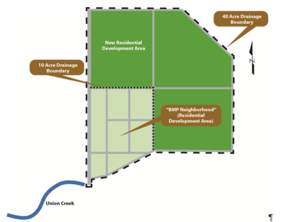
Difference between revisions of "Scenario for developing a stormwater treatment train for constructed ponds in new development"
| Line 15: | Line 15: | ||
====Step 2: Review Pollutant Removal Processes & Identify Potential Practices==== | ====Step 2: Review Pollutant Removal Processes & Identify Potential Practices==== | ||
| − | The BMPs selected for the New Development site need to achieve the goals of decreased runoff volume or peak flow rate attenuation and pollutant removal, as well as fit within the site constraints. | + | The BMPs selected for the New Development site need to achieve the goals of decreased runoff volume or peak flow rate attenuation and pollutant removal, as well as fit within the site constraints. The New Development Scenario BMP Practice Selection table below discusses the applicability of BMP practices to this site. |
| − | + | {{:New Development Scenario BMP Practice Selection}} | |
| + | |||
| + | Infiltrator, filter, swales & strips, and constructed basin BMPs are determined to best address the goals of this project for the New Development scenario. The process of selecting and placing BMPs on a site is typically iterative, working between the site constraints, project goals, and available budget. The approach and considerations for this scenario are discussed in the following sections. | ||
Revision as of 21:24, 14 July 2015
Contents
Treatment Train Scenarios
New Development & Stormwater Ponds in Series Scenarios
Step 1: Review Project Goals & Site Conditions
This scenario is for a new residential development in the rural town in central Minnesota. The new development is to be 40 acres with four 10-acre sub-neighborhoods. The upstream neighborhoods have slopes of 2% draining to the downstream southwest neighborhood, hereby referred to as the “BMP Neighborhood.” The basic site conditions for the New Development setting are summarized in Table 3.5.1. For this scenario two treatment train options will be evaluated: a Varied BMP Approach and Stormwater Ponds in Series Approach. The existing site layout for the New Development scenario can be seen in the New Residential Development Scenario Base schematic.
At the southwest corner of the BMP Neighborhood is an outlet to Union Creek, which continues southwest to a small lake. This lake is known to be nutrient impaired with excess levels of phosphorous possibly due to fertilizer use from upstream lawns, gardens and agricultural areas. The use of fertilizers is not uncommon and often necessary as sandy soils are generally not productive for vegetation growth. Interception of nutrients through BMPs before entering the stream system is a preferable method of pollutant reduction for this project. The New Development Scenario Existing Site Condition table below describes the site conditions for this new development.
New Development Scenario Existing Site Conditions
Step 2: Review Pollutant Removal Processes & Identify Potential Practices
The BMPs selected for the New Development site need to achieve the goals of decreased runoff volume or peak flow rate attenuation and pollutant removal, as well as fit within the site constraints. The New Development Scenario BMP Practice Selection table below discusses the applicability of BMP practices to this site.
New Development Scenario BMP Practice Selection
Infiltrator, filter, swales & strips, and constructed basin BMPs are determined to best address the goals of this project for the New Development scenario. The process of selecting and placing BMPs on a site is typically iterative, working between the site constraints, project goals, and available budget. The approach and considerations for this scenario are discussed in the following sections.
